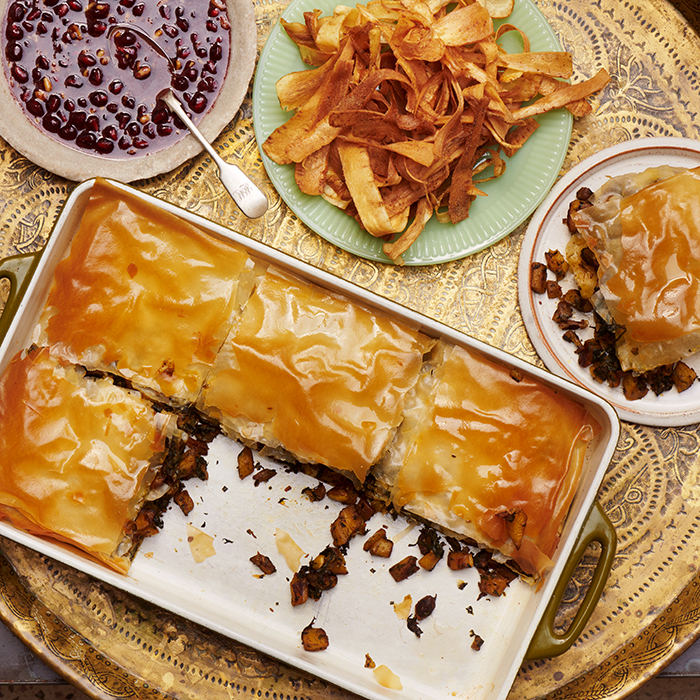Essential ingredients: parsnips
Author: Stewart Turner

I’m often asked which of the seasons is my favourite in terms of produce, and I’m always stumped for an answer, because they each have their own distinctive ingredients. Although most things are now available all year (as they are in season somewhere in the world!), I think that seasonality is important, not just because the ingredients are at their best, without having travelled halfway round the world, but also because it pushes us to look at different produce periodically and keep innovating.
As we move into the autumn and early winter, it’s all about the game, squash and roots. Root vegetables come in such an amazing array of colours and textures; I feel that they add such a palette of colours to our dishes when the weather can sometimes be a bit grey.
Parsnips are one of my favourites. They are such a versatile vegetable and take on flavour so well. As a fully fledged carnivore, I often feel that I have to work especially hard to come up with really interesting and comparable dishes for our vegetarian guests. This dish is from our current menus; we normally make individual ones and incorporate parsnips in different preparations, but to simplify things I’ve just made a large one.
- 1kg parsnips – peeled, core removed and roughly chopped
- 1 tbsp ras el hanout
- 1 tbsp ground cumin
- I pinch of saffron
- 250g young spinach
- 2 onions – peeled and finely chopped
- 2 garlic cloves – peeled and finely chopped
- 50g toasted pistachio nuts
- 2 tbsp coriander – chopped
- 1 tbsp chives – chopped
- 6 large sheets of filo pastry
- 100g butter – melted
- 1 large pinch of sumac
- Olive oil
- Salt and freshly ground pepper
- Parsnips crisps (optional – see separate recipe below)
Preheat the oven to 160°C. Heat the oil in a large frying pan, pan-fry the chopped parsnips until lightly golden. Transfer to a baking tray and bake in the oven until tender (about 15 to 20 minutes). Remove from the oven and allow to cool.
Heat another splash of oil in the pan. Cook the onion and garlic over a medium heat for about five minutes, until soft and lightly browned. Add the ras el hanout and cumin, and cook the mixture for a further two or three minutes. Mix in the spinach leaves and allow to wilt, then drain well.
Combine the cooked parsnips with the onion and spinach mixture. Add the chopped herbs, season with salt and freshly ground pepper, then mix in the saffron and pistachio nuts. Set aside.
To assemble the pastilla, butter a large ovenproof dish. Brush a sheet of filo liberally with melted butter and drape it over the dish, gently pushing into the sides without tearing. Repeat with another sheet of filo, this time placing it at a right angle to the first. Add two more sheets placing them on the diagonal.
Spoon the filling into the centre of the pastry. Fold the pastry back over the filling, starting with the last piece to be laid and finishing with the first, so that it’s completely covered. Butter the two remaining pieces of filo and cut them to fit the dish. Place over the top of the pastilla, tucking in the sides.
Bake the in the oven for about 20 minutes until the pastry is a crisp and golden brown. Once cooked, remove from the oven and allow to cool slightly, before finishing with a good pinch of sumac and – if using – the parsnip crisps.
Pomegranate dressing
- 2 pomegranates
- 1 tbsp pomegranate molasses
- 1 clove garlic – crushed
- 1 pinch of cumin seeds – toasted
- 1 tsp Dijon mustard
- 2 tbsp Cabernet Sauvignon vinegar
- 75ml olive oil
- 50g toasted pine nuts – lightly broken
- 1 small bunch of chives – finely chopped
Deseed the pomegranate over a bowl, catching all the juice. Retain half the pomegranate seeds. Put the remaining seeds in a blender with any juice and pass the resulting mixture through a sieve. Place in a pan with the garlic and cumin, and boil over a high heat until reduced by half.
Pass into a bowl discarding the garlic and cumin. Whisk in the mustard, molasses and vinegar, then slowly add the oil, whisking as you do. Season with salt and pepper. Mix in the reserved pomegranate seeds and pine nuts. Cover and set aside until required.
Parsnip crisps
- 2 parsnips – peeled then cut into thin strips using the peeler
- 500ml sunflower oil
- 1 tsp curry powder
- 1/2 tsp salt
Preheat the oil in a deep fat fryer to 160°C. Mix together the curry powder and salt. Fry the parsnip slices in the hot oil until golden brown, stirring continuously so you get an even colour. Remove from the fryer and place on kitchen towel to drain. While still warm, season with the curry salt.
What to drink: The sweetness of parsnips demands a similarly sweet fruit core to the wine on hand, which will also help handle the Middle Eastern spices. For reds, look for a juicy Zinfandel – which will combine the requisite fruit and spice (such as Bedrock’s Whole Shebang), or a vibrant Côtes du Rhône (try this from Domaine Dieu-le-Fit). Equally, fuller styles of white would work here too: off-dry Pinot Gris (Alsace would be the classic choice, but why not try this Kiwi one) could be beautiful, while a richer style of Chenin Blanc from South Africa would have the weight to balance the flavours, and enough zing to keep things fresh (like this one from Vincent Carême).


